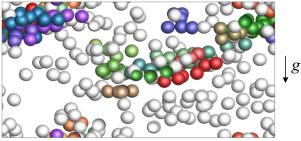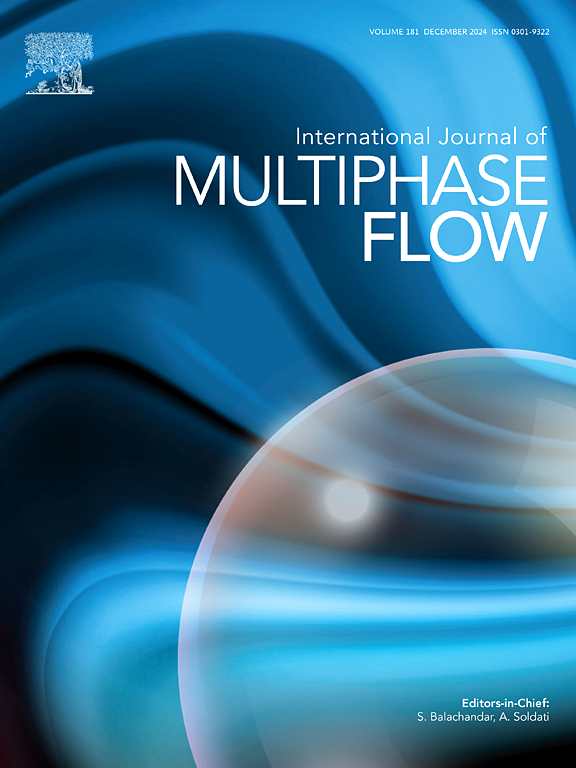A numerical study on the clustering characteristics of rising air bubbles in stagnant water
IF 3.8
2区 工程技术
Q1 MECHANICS
International Journal of Multiphase Flow
Pub Date : 2025-09-11
DOI:10.1016/j.ijmultiphaseflow.2025.105419
引用次数: 0
Abstract
We perform numerical simulations of rising air bubbles in stagnant water to investigate their clustering characteristics. Monodispersed rising bubbles are simulated in a periodic computational box for three cases of bubble equivalent diameters ( and 1.5 mm), respectively. The bubble cluster is identified based on an inter-bubble-distance criterion (Ma et al., 2023) and its characteristics is analyzed. Initially, the bubbles are uniformly distributed throughout the domain. The bubbles with retain their initial distribution, while those with and 1.5 mm interact among themselves, leading to clustering. For the larger bubbles ( and 1.5 mm), simulations with a small horizontal domain size result in a stable formation of domain-full horizontal bubble clustering. However, when the horizontal domain size is sufficiently large, such clustering no longer occurs, but local sheet-like clustering, aligned nearly parallel to the horizontal direction, occurs. During bubble collision and bouncing-off, a counter-rotating vortex pair is generated and induces a downward velocity on the bubbles, which decreases their rising velocity and keeps the bubbles horizontally aligned.

滞水中上升气泡聚集特性的数值研究
本文对滞水中上升气泡进行数值模拟,研究气泡的聚类特征。在周期计算箱中对三种气泡当量直径(deq=0.5,1和1.5 mm)的单分散上升气泡进行了模拟。基于气泡间距离标准(Ma et al., 2023)识别气泡簇,并分析其特征。最初,气泡均匀分布在整个区域。deq=0.5mm的气泡保持其初始分布,而deq=1和1.5 mm的气泡相互作用,形成聚类。对于较大的气泡(deq=1和1.5 mm),采用小水平畴尺寸的模拟结果可以稳定地形成满畴的水平气泡簇。然而,当水平域的大小足够大时,这种聚类不再发生,而是发生与水平方向几乎平行的局部片状聚类。在气泡碰撞和反弹过程中,会产生一个反向旋转的涡对,并在气泡上产生一个向下的速度,从而降低气泡的上升速度,使气泡保持水平排列。
本文章由计算机程序翻译,如有差异,请以英文原文为准。
求助全文
约1分钟内获得全文
求助全文
来源期刊
CiteScore
7.30
自引率
10.50%
发文量
244
审稿时长
4 months
期刊介绍:
The International Journal of Multiphase Flow publishes analytical, numerical and experimental articles of lasting interest. The scope of the journal includes all aspects of mass, momentum and energy exchange phenomena among different phases such as occur in disperse flows, gas–liquid and liquid–liquid flows, flows in porous media, boiling, granular flows and others.
The journal publishes full papers, brief communications and conference announcements.

 求助内容:
求助内容: 应助结果提醒方式:
应助结果提醒方式:


